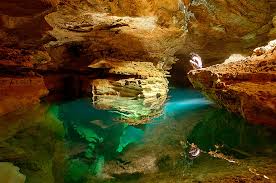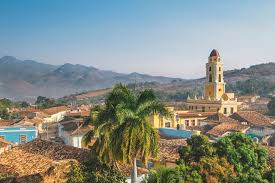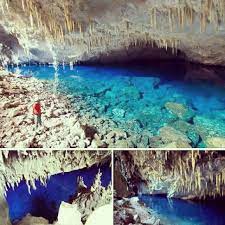CUEVAS DE BELLAMAR, MATANZAS, CUBA: EL HALLAZGO PALEONTOLÓGICO MÁS IMPORTANTE DE LA ISLA. FOTOS
Son un conjunto de cavernas de más de 23 kilómetros de galerías ubicadas en la provincia de Matanzas, Cuba. Por la belleza de sus galerías y cavernas, los importantes hallazgos paleontológicos, así como una amplia gama de procesos cristalinos, fueron declaradas Monumento Nacional.
Se estima que las galerías y pasadizos de las Cuevas de Bellamar comenzaron a formarse hace unos 300.000 años. Según los estudiosos, la planicie donde se ubican las cuevas estaba originalmente bajo el mar, formando parte de la Bahía de Matanzas. A lo largo de la llamada Falla de Bellamar, el agua subterránea, en combinación con el dióxido de carbono, disolvió la roca calcárea y así creó cámaras subterráneas en el subsuelo; bajo el fondo del mar.
Mientras permanecieron bajo el nivel del mar, estas cavernas estuvieron llenas de agua. Los movimientos tectónicos hicieron que la zona se elevara, hasta formar las terrazas marinas que se pueden observar en la ciudad de Matanzas y sus alrededores.
Con el paso del tiempo estas cavernas se fueron secando; incluso se drenaron algunas cavidades que se encuentran muy por debajo del nivel del mar y comenzaron a producirse filtraciones entre las rocas, en el techo de las cuevas, de agua con carbonato de calcio disuelto que al escurrir dejaba residuos y de esta forma se formaban las estalactitas de las techo y las estalagmitas en el suelo.
DESCUBRIMIENTO
Las Cuevas de Bellamar fueron descubiertas por casualidad en febrero de 1861 cuando un esclavo perdió su palanca al abrir un agujero en el suelo, tratando de sacar una piedra caliza. El esclavo y el capataz imaginaron que la tierra se había tragado la barreta.
Don Manuel Santos Parga, dueño de la finca, pidió explicaciones y al no recibir respuestas se dirigió al lugar de los hechos, mandó cavar allí; y luego que se hubo abierto un espacio de poco más de una vara, salió por el agujero una gran corriente de aire de olor repulsivo; caliente y ahumado; entonces la entrada a la cueva quedó así expuesta.
El señor Parga, que sabía cosas de minas y cuevas, se dio cuenta de lo que significaba el descubrimiento y comenzó a preparar la cueva para que los visitantes pudieran disfrutarla. Sacaron muchas piedras; hicieron escaleras de mampostería que aún se encuentran en uso; instalaron pasamanos; y en cuanto fue una realidad, instaló luz eléctrica. Él o uno de los guías a su cargo conducía a los turistas a través de los pasillos de la cueva mientras explicaba lo que estaban viendo. Dos años después del hecho, José V. Betancourt, de Matanzas, narró lo sucedido.
Originalmente denominada Cuevas de Parga en homenaje a su descubridor, el punto cambió su nombre por el de Las Cuevas de Bellamar, en plural, (aunque los especialistas indican que se trata de una sola cueva con varias estancias) debido a su proximidad a la playa homónima en el occidente de Matanzas.
En los dos primeros años lo visitaron más de dos mil personas. En su momento fue un éxito rotundo, tanto turístico como científico.
CARACTERÍSTICAS
Las estalactitas son cilíndricas, ya medida que aumenta su tamaño se vuelven cónicas mientras que las estalagmitas son cónicas o aplanadas, como si estuvieran derretidas. Ambos crecen para unirse y formar columnas.
En algunos casos, varias estalactitas relativamente cercanas se juntan dando lugar a formaciones llamadas arbustos. Otros corren pegados a la pared formando cascadas. En las Cuevas de Bellamar puedes ver todas estas formaciones.
Muy interesantes en las Cuevas de Bellamar son sus formaciones cristalinas transparentes y brillantes que no se originan de la misma forma que otras estructuras nombradas. Se originan a partir de geodas llenas de agua. Y más interesante resulta que en ciertas cavidades de las cuevas las formaciones sedimentarias están cubiertas por una capa cristalina, lo que indica que después de haberse secado, estas cámaras volvieron a inundarse por completo, o al menos parcialmente.
En la sala principal se encuentra la formación rocosa conocida como Manto de Colón. Esta es la más grande y antigua que se presenta en forma de cascada y tiene una altura de 12 metros.
Dividido en cuatro sectores, sus galerías y salones están tapizados de estalactitas, estalagmitas y helictitas, estas últimas con caprichosas formas horizontales.
Diseñado por la naturaleza y bautizado por el hombre, se encuentra el túnel del amor, la capilla de los 12 apóstoles, la Garganta del Diablo, el Paso de la Lluvia, el Salón de las Nieves y los templos de San Pedro y Gótico.
Estas cuevas presentan una rara belleza en el mundo de las cavernas debido a que muchas de las formaciones son resplandecientes debido a la capa cristalina que las cubre.
La entrada a las Cuevas de Bellamar se realiza a través de la cavidad denominada Sala Gótica, una cámara de forma cuadrada que mide unos 80 metros de largo por unos 25 metros de ancho.
En la sala gótica se ha dado nombre a algunas de las formaciones; entre otros se encuentra El Huerto de las Zanahorias, La Capilla de los Doce Apóstoles, Doña Mamerta y el famoso Manto de Colón. Pero las Cuevas de Bellamar no son sólo esta sala, la cavidad se extiende hacia el este y el oeste alcanzando una longitud que supera los tres kilómetros de largo; y se sabe que es mucho más grande, con cámaras todavía completamente inundadas.
Otras cavidades son la Galería de los Dos Lagos, la Sala de las Esponjas, la Galería de los Enanos y la Galería del Megalocnus al este de la Sala Gótica. En el otro sentido se encuentran el Pasaje Hatuey, el Salón de las Damas, el Lago de las Dalias y el Baño de la Americana. Sobre este último existe la leyenda de que una veraneante estadounidense, hace muchos años, se perdió en ese lugar, cuando decidió refrescar su cuerpo en las cristalinas y frías aguas.
Según los científicos es una sola cueva con varias habitaciones, pero la costumbre la trata en plural. El aire allí es respirable, al menos donde el visitante podía llegar. La temperatura es relativamente estable durante todo el año, manteniéndose en los 26ºC.
Para los amantes de la Espeleología, las Cuevas de Bellamar también son consideradas un potencial laboratorio para el estudio de la cristalografía subterránea, en particular la derivada del carbonato cálcico, ya que en sus galerías se puede encontrar una amplia representación de formas cristalinas de singular belleza.
La antigüedad de sus galerías y niveles permitió que sirvieran de refugio a la fauna cuaternaria de la región, hecho confirmado por el hallazgo en las excavaciones de restos de animales prehistóricos, además de localizar la mayor cavidad de origen freático en Cuba en la zona.
NUEVOS DESCUBRIMIENTOS
De relevante interés científico aquí son los nuevos hallazgos en un segmento del Sistema de Cuevas de Bellamar, un distinguido Monumento Nacional.
En la cueva centenaria, un grupo de espeleólogos descubrió una estrecha cavidad que les condujo a otra extensión subterránea de unos nueve kilómetros de largo. Para sorpresa de todos, allí encontraron galerías de incomparable belleza.
Se trata de formaciones cilíndricas que penden de estalactitas, y suspendidas en el aire, en cuyos extremos pende un conglomerado de cristales sólidos de calcita. Por su tamaño y rareza, los especialistas consideran el hallazgo como una joya exclusiva, incomparable con cualquier otro hallazgo de este tipo. Son formaciones indescriptibles, ya que en ningún otro lugar del planeta se conocen tales cristalerías de carbonato de calcio.
En continuas exploraciones del grupo espeleológico de Félix Rodríguez de la Fuente, aparecieron otros hallazgos paleontológicos de gran interés científico, como restos de vertebrados terrestres y aves cuya antigüedad se estima en millones de años.
Entidades especializadas contabilizan más de 10.000 cuevas a lo largo de la isla, muchas de ellas con unos 25 millones de años de evolución.
Algunas secciones están dentro de los cincuenta pies bajo el nivel del mar. Entendemos que a los turistas no se les permite ir tan profundo, más como la mitad de esa profundidad. El aire es respirable, al menos donde se le permitió llegar al visitante. La temperatura es relativamente estable durante todo el año, manteniéndose en unos 80 º F (26 º C).
BELLAMAR CAVES, MATANZAS, CUBA: THE MOST IMPORTANT PALEONTOLOGICAL FINDING ON THE ISLAND. PHOTOS
They are a set of caverns of more than 23 kilometers of galleries located in the Matanzas province, Cuba. Due to the beauty of its galleries and caverns, the important paleontological findings, as well as a wide range of crystalline processes, they were declared a National Monument.
The galleries and passageways of the Bellamar Caves are estimated to have begun to form about 300,000 years ago. According to scholars, the plain where the caves are located was originally under the sea, forming part of the Matanzas Bay. Throughout the so-called Bellamar Fault, groundwater, in combination with carbon dioxide, dissolved the calcareous rock and thus created underground chambers in the subsoil; under the seabed.
As long as they remained below sea level, these caverns were filled with water. Tectonic movements caused the area to rise, until it formed the marine terraces that can be seen in the city of Matanzas and its surroundings.
With the passing of time these caverns dried up; even some cavities that are deep below sea level were drained and seepage began to take place between the rocks, on the roof of the caves, of water with dissolved lime carbonate that left residues when dripping and, in this way, formed the stalactites from the ceiling and the stalagmites on the floor.
DISCOVERY
The Bellamar Caves were discovered by chance in February 1861 when a slave lost his crowbar opening a hole in the ground, trying to remove a lime rock. The slave and the overseer imagined that the earth had swallowed the barreta.
Don Manuel Santos Parga, owner of the farm, asked for explanations and when he did not receive answers he went to the place of the events, ordered that they be dug there; and as soon as a space of a little more than a rod had been opened, a great current of repulsive smelling air came out through the hole; hot and smoky; then the entrance to the cave was thus exposed.
Mr. Parga, who knew things about mines and caves, realized what the discovery meant and began to prepare the cave so that visitors could enjoy it. They took out many stones; they made masonry stairs that are still in use; they installed handrails; and as soon as it was a reality, he installed electric light. He or one of the guides under his employ would lead tourists through the passageways of the cave while explaining what they were seeing. Two years after the event, José V. Betancourt, from Matanzas, narrated what happened.
Originally called the Cuevas de Parga in homage to its discoverer, the point changed its name to Las Cuevas de Bellamar, in the plural, (although specialists indicate that it is a single cave with several rooms) due to its proximity to the homonymous beach in the west of Matanzas.
In the first two years more than two thousand people visited it. At that time it was a resounding success, both tourist and scientific.
CHARACTERISTICS
The stalactites are cylindrical, and as their size increases they become conical while the stalagmites are conical or flattened, as if melted. Both grow to join and form columns.
In some cases, several relatively close stalactites join together, giving rise to formations called bushes. Others run close to the wall forming waterfalls. In the Bellamar Caves you can see all these formations.
Very interesting in the Bellamar Caves are its transparent and shiny crystalline formations which do not originate in the same way as other named structures. They originate from geodes filled with water. And more interesting it turns out that in certain cavities of the caves the sedimentary formations are covered by a crystalline layer, indicating that after having dried, these chambers returned to flood completely, or at least partially.
In the main hall is the rock formation known as Manto de Colón. This is the largest and oldest that is presented in the form of a waterfall and has a height of 12 meters.
Divided into four sectors, its galleries and halls are upholstered with stalactites, stalagmites and helictites, the latter with whimsical horizontal shapes.
Designed by nature and baptized by man, there is the tunnel of love, the chapel of the 12 apostles, the Garganta del Diablo, the Paso de la Lluvia, the Salón de las Nieves and the temples of San Pedro and Gótico.
These caves present a rare beauty in the world of caves because many of the formations are resplendent due to the crystalline layer that covers them.
The entrance to the Bellamar Caves is through the cavity called the Gothic Hall, a square-shaped chamber that measures about 80 meters long by about 25 meters wide.
In the Gothic room, some of the formations have been given names; among others is El Huerto de las Zanahorias, The Chapel of the Twelve Apostles, Doña Mamerta and the famous Mantle of Columbus. But the Bellamar Caves are not just this room, the cavity extends to the east and west reaching a length that exceeds three kilometers long; and it is known to be much larger, with chambers still fully flooded.
Other cavities are the Gallery of the Two Lakes, the Hall of the Sponges, the Gallery of the Dwarfs and the Gallery of the Megalocnus to the east of the Gothic Hall. In the other direction are the Hatuey passageway, the Salón de las Damas, Lago de las Dalias and the Baño de la Americana. About the latter there is a legend that an American vacationer, many years ago, got lost in that place, when she decided to refresh her body in the crystal clear and cold waters.
According to scientists it is a single cave with several rooms, but custom treats it in the plural. The air there is breathable, at least where the visitor was allowed to reach. The temperature is relatively stable throughout the year, staying at 26ºC.
For connoisseurs of Speleology, the Bellamar Caves are also considered a potential laboratory for the study of subterranean crystallography, particularly those derived from calcium carbonate, as a wide representation of crystalline forms of singular beauty can be found in its galleries.
The antiquity of its galleries and levels allowed them to serve as a refuge for the Quaternary fauna of the region, a fact confirmed by the discovery in the excavations of remains of prehistoric animals, in addition to locating the largest cavity of phreatic origin in Cuba in the area.
NEW DISCOVERIES
Of relevant scientific interest here are the new findings in a segment of the Bellamar Cave System, a distinguished National Monument.
In the hundred-year-old cave, a group of speleologists discovered a narrow cavity that led them to another underground extension about nine kilometers long. To everyone’s surprise, they found galleries of incomparable beauty there.
These are cylindrical formations hanging from stalactites, and suspended in the air, at the ends of which hang a conglomerate of solid calcite crystals. Due to its size and rarity, specialists consider the discovery as an exclusive jewel, incomparable with any other find of its kind. They are indescribable formations, since nowhere else on the planet is such calcium carbonate glassware known.
In continued explorations by the Félix Rodríguez de la Fuente speleological group, other paleontological discoveries of significant scientific interest appeared, such as remains of terrestrial vertebrates and birds whose antiquity is estimated to be millions of years.
Specialized entities count more than 10,000 caves throughout the island, many of them with some 25 million years of evolution.
Some sections are within fifty feet below sea level. We understand that tourists are not allowed to go as deep, more like half that depth. The air is breathable, at least where he was allowed to reach the visitor. The temperature is relatively stable throughout the year, remaining at about 80 º F (26 º C).
Agencies/ Wiki/ CuevasBellamarHis./ Ecured/ Internet Photos/ Arnoldo Varona/ www.TheCubanHistory.com
THE CUBAN HISTORY, HOLLYWOOD.



 BELLAMAR CAVES, Matanzas, Cuba: the Most Important Paleontological finding on the Island. PHOTOS. * CUEVAS DE BELLAMAR, Matanzas, Cuba: el Hallazgo Paleontológico Más Importante de la Isla. PHOTOS.
BELLAMAR CAVES, Matanzas, Cuba: the Most Important Paleontological finding on the Island. PHOTOS. * CUEVAS DE BELLAMAR, Matanzas, Cuba: el Hallazgo Paleontológico Más Importante de la Isla. PHOTOS.








